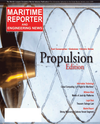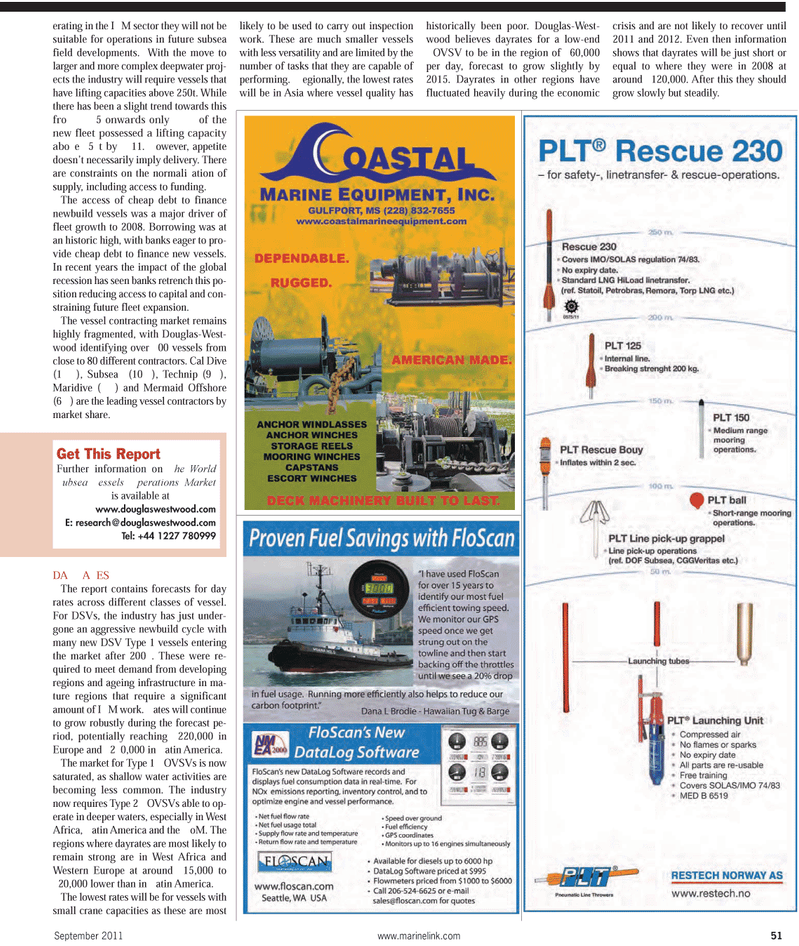
Page 51: of Maritime Reporter Magazine (September 2011)
Marine Propulsion Annual
Read this page in Pdf, Flash or Html5 edition of September 2011 Maritime Reporter Magazine
erating in the IM sector they will not be suitable for operations in future subseafield developments. With the move to larger and more complex deepwater proj- ects the industry will require vessels that have lifting capacities above 250t. While there has been a slight trend towards this fro 5 onwards only of the new fleet possessed a lifting capacityaboe 5t by 11. owever, appetite doesn?t necessarily imply delivery. There are constraints on the normaliation of supply, including access to funding. The access of cheap debt to finance newbuild vessels was a major driver of fleet growth to 2008. Borrowing was at an historic high, with banks eager to pro-vide cheap debt to finance new vessels. In recent years the impact of the globalrecession has seen banks retrench this po-sition reducing access to capital and con-straining future fleet expansion. The vessel contracting market remains highly fragmented, with Douglas-West- wood identifying over 00 vessels from close to 80 different contractors. Cal Dive (1), Subsea (10), Technip (9), Maridive () and Mermaid Offshore (6) are the leading vessel contractors by market share. DAAES The report contains forecasts for dayrates across different classes of vessel. For DSVs, the industry has just under- gone an aggressive newbuild cycle with many new DSV Type 1 vessels entering the market after 200. These were re- quired to meet demand from developing regions and ageing infrastructure in ma- ture regions that require a significant amount of IM work. ates will continue to grow robustly during the forecast pe- riod, potentially reaching 220,000 in Europe and 20,000 in atin America. The market for Type 1 OVSVs is now saturated, as shallow water activities are becoming less common. The industry now requires Type 2 OVSVs able to op- erate in deeper waters, especially in West Africa, atin America and the oM. The regions where dayrates are most likely to remain strong are in West Africa and Western Europe at around 15,000 to 20,000 lower than in atin America. The lowest rates will be for vessels with small crane capacities as these are mostlikely to be used to carry out inspection work. These are much smaller vessels with less versatility and are limited by the number of tasks that they are capable of performing. egionally, the lowest rates will be in Asia where vessel quality has historically been poor. Douglas-West- wood believes dayrates for a low-end OVSV to be in the region of 60,000 per day, forecast to grow slightly by 2015. Dayrates in other regions have fluctuated heavily during the economic crisis and are not likely to recover until 2011 and 2012. Even then information shows that dayrates will be just short or equal to where they were in 2008 at around 120,000. After this they should grow slowly but steadily. September 2011www.marinelink.com 51Get This ReportFurther information on he World ubsea essels perations Market is available at www.douglaswestwood.com E: [email protected] Tel: +44 1227 780999

 50
50

 52
52
